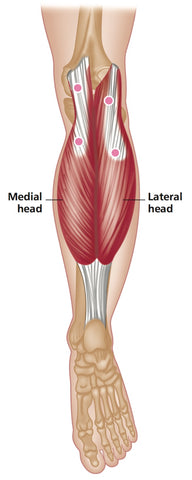Trigger Point Therapy - Treating Achilles Tendinitis

Achilles Tendinitis
Achilles Tendinitis - Trigger Point Therapy
Achilles problems are amongst the most common issues that therapists deal with every day - especially with clients who are regular runners or walkers
In many cases, poor footwear or a change of footwear to a new design, is the cause.
Trigger points form to weaken muscles of the calf in particular, creating a chain effect and ultimately additional trigger points and a reaction in the achilles.
Trigger Point Treatment Protocol
Trigger point therapy can be wonderfully effective for treating achilles issues.
Here (video above) we demonstrate the most commonly used NAT trigger point protocols for treating achilles tendinitis.
Bear in mind that we're only showing brief highlights of the treatment process and do not attempt to perform these trigger point techniques unless they fall within your professional scope of practice.
Achilles tendinitis is typically associated with trigger points in the gastrocnemius, soleus, and plantaris muscles.
Achilles Tendinitis - Overview
The Achilles tendon crosses the back of the heel, which means it rides over the bone as the muscle contracts and stretches.
Inflammation of the Achilles tendon can be very painful; all of the body’s weight is supported by this structure and footwear often presses against this area.
Repetitive stress to the tendon can lead to inflammation that causes additional irritation and further inflammation.
Activities such as basketball, running, volleyball and other running and jumping sports can lead to Achilles tendinitis.
Repetitive contraction of the muscles in the calf and improper footwear or excessive pronation of the feet can lead to inflammation in the tendon.
Cause of Injury
Repetitive stress from running and jumping activities. Improper footwear or awkward landing pattern of the foot during running. Untreated injuries to the calf or Achilles tendon.
Signs and Symptoms
Pain and tenderness in the tendon. Swelling may be present. Contraction of the calf muscle causes pain; running and jumping may be difficult.
Complications if Left Unattended
Inflammation in the tendon can lead to deterioration of the tendon and eventual rupture if left untreated. Inflammation may lead to tightening of the tendon and attached muscle which could lead to tearing.
Immediate Treatment
Rest, reducing or discontinuing the offending activity. Ice. Anti-inflammatory medication. Trigger point therapy. Then heat and massage to promote blood flow and healing.
Rehabilitation and Prevention
After a period of rest, usually lasting 5–10 days, gentle stretching and strengthening exercises can be initiated.
Heat may be used on the tendon before activity to warm the tendon properly.
Adequate warm-up, along with strengthening and stretching exercises for the calves, will help prevent tendinitis of the Achilles tendon.
Long-Term Prognosis
Tendinitis seldom has lingering effects if treated properly. Tendinitis may take from five days to several weeks to heal but rarely needs surgery to repair it.
Stretching
If you are receiving any form of trigger point therapy, either self-help or with a therapist, it is advisable to stretch on the hour, every hour, on the day of the treatment and then three times per day thereafter for a few weeks to several months.
Below you'll find some useful self help techniques.

Technique
Stand upright and lean against a wall. Place one foot as far from the wall as is comfortable and make sure that both toes are facing forward and your heel is on the ground. Keep your back leg straight and lean towards the wall.
This stretch can put a lot of pressure on the Achilles tendon. Ease into this stretch by slowly lowering your heel in a carefully controlled manner.
Muscles being stretched
Primary muscle: Gastrocnemius.
Secondary muscles: Tibialis posterior. Flexor hallucis longus. Flexor digitorum longus. Peroneus longus and brevis. Plantaris.
Injury where stretch may be useful
Calf strain. Achilles tendon strain. Achilles tendonitis. Medial tibial pain syndrome (shin splints).
General self help tips
There are many reasons why you might have trigger points, so it is important to consider your trigger point pain in the context of the rest of your body.
The techniques offered on this page are not a substitute for therapy from a qualified practitioner.
Although aches and pains from trigger points are common, there can sometimes be an underlying pathology.
It is advisable to always seek a proper diagnosis from a qualified medical practitioner or suitably qualified manual therapist

Gastrocnemius - Common Trigger Point Sites

Soleus - Common Trigger Point Sites
Self help trigger point massage (hard ball)
This technique involves locating the heart of the trigger/tender point. When this is compressed it may well trigger a specific referred pain map (preferably reproducing your symptoms). This technique involves applying direct, gentle and sustained pressure to the point, as follows:

Procedure
1. Identify the tender/trigger point you wish to work on.
2. Place the host muscle in a comfortable position, where it is relaxed and can undergo full stretch.
3. Apply gentle, gradually increasing pressure to the tender point until you feel resistance. This should be experienced as discomfort and not as pain.
4. Apply sustained pressure until you feel the tender point yield and soften. This can take from a few seconds to several minutes.
5. Steps 3-4 can be repeated, gradually increasing the pressure on the tender/trigger point until it has fully yielded.
6. To achieve a better result, you can try to change the direction of pressure during these repetitions.

Ready to take your practice to the next level?
Explore which continuing education course is right for you.








